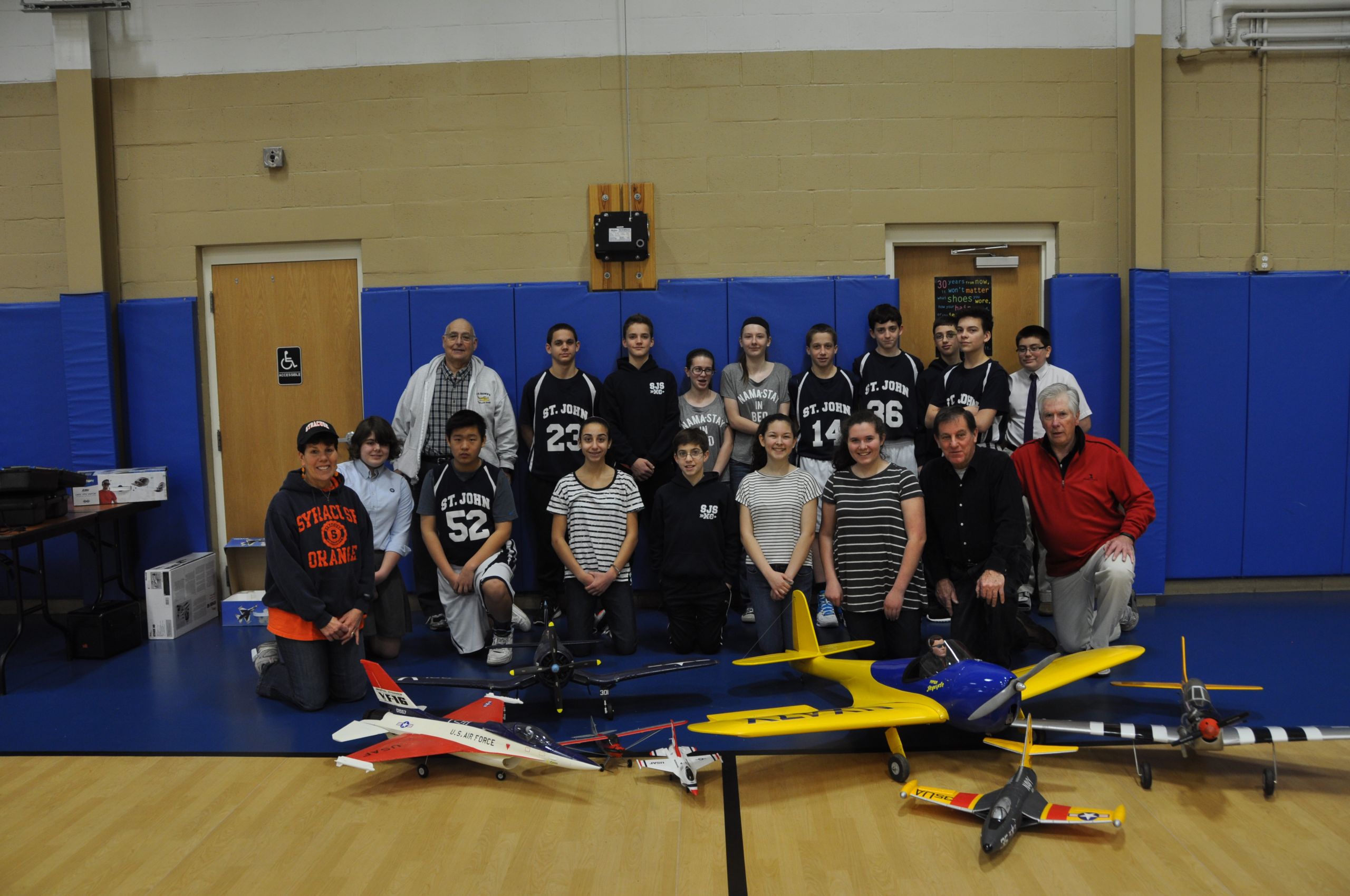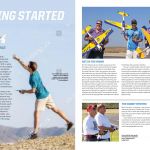Getting Started in Radio Control

NO ONE IS BORN WITH FLYING SKILLS. Everyone has to start at the beginning. This is an excellent article on the basics of getting started in model aviation (click image): 
Information For Applicants
There are many aspects of radio control aircraft that are powered by piston engines (2 stroke and 4 stroke) as well as by electric motors. Sailplanes are primarily winch-powered, but also may carry an electric motor or a small piston engine on a power pod. A wide range of helicopters are also available to the RC flyer.
These models vary in size from 2 to 3 lbs. up to as much as 55 lbs. Radio control aircraft can perform and exceed maneuvers that a full-scale aircraft can perform. RC models should be considered as real aircraft, with the pilot controlling remotely from the ground. This relationship requires the pilot to learn to fly the aircraft as it flies away from the pilot, but also in reverse as it flies toward the pilot. The performance of the model is based upon the building and flying skills of the modeler.
How To Get Started
To join FLYRC and fly you must be a member of the Academy of Model Aeronautics (AMA). Applications to the AMA may be obtained here. Your AMA membership provides limited liability insurance and the monthly magazine Model Aviation. The AMA is the governing body of model aviation in the USA. The applicant must also complete a formal application obtained here and pay the club dues.
Also, the Federal Aviation Administration (FAA) has recently imposed two further requirements to engage legally in model radio-controlled aviation.
- All FlyRC members must apply for and complete The Recreational UAS (Unmanned Aircraft Systems) Safety Test (TRUST). The test is not particularly challenging and can be accessed here. This requirement applies to all radio-controlled drone, helicopter, and fixed-wing aircraft pilots.
- Once a TRUST certification has been received, the FAA requires that all remote aircraft pilots create an account at the agency’s website for managing drone services, FAADroneZone. All aircraft over the weight of 0.55 lbs. must be registered and properly labelled.
Sponsorship
Additionally, an applicant must have a club sponsor. The sponsor will sign the club application that must be submitted to the membership chairman. The applicant is now ready to pursue his or her new-found hobby. The sponsor will assist the applicant in obtaining information and suggestions from all available sources relevant to acquiring appropriate models and the necessary associated equipment.
Modeling Suggestions
All power modelers will need a trainer model, engine or motor, radio with all associated accessories, a well-equipped field box, fuel as required, and battery. Building materials such as glue, sandpaper, and covering material will vary greatly depending on the nature of the model purchased. Accessories will also vary greatly depending on the system required to power the aircraft. The sponsor can assist the new member to obtain any additional materials and equipment.
The Completed Model
Before flying the new model, it must be thoroughly inspected to insure safe and proper operation. The sponsor should perform the inspection, establish the flight training program requirements, and brief the applicant fully on those flight training requirements, leading finally to a competency examination. Field and flight safety shall be stressed from the outset.
Applicant Procedure
- Every applicant must obtain a sponsor who will assist him or her in the fundamentals of joining FLYRC. Your sponsor should be a guide through the initial stages of selecting, building, and checkout of your model aircraft. The sponsor will also be responsible for your conduct as an applicant. It is not the responsibility of the club or its officers to find you a sponsor. If you are interested in joining, become active by attending meetings and flying sessions. This is how to meet those who may be willing to sponsor you. At all times, AMA membership will be required to fly.
- Your sponsor must be a member of this club in good standing, and must be willing to assist you. He/she will either instruct you in basic flying skills, or will put you in contact with someone who can instruct you. An applicant is never to fly unsupervised. To do so will lead to immediate expulsion from the club.
- Your instructors will guide you through the skills necessary to pass a basic flight test once you have obtained your AMA card. It is advised that you stay with one instructor throughout the training process so as to maintain continuity. It is generally best to have a time scheduled with your instructor and be there promptly. He has volunteered his flying time to teach you, so please respect the courtesy you are being provided.
- Your aircraft should be able to pass a preflight safety test by a qualified instructor or examiner. This is for your protection as well as for the preservation of your aircraft. Your sponsor
can make the arrangements to have this done. - When your instructor or a member in good standing feels confident that you can pass the basic flying skills test, he/she will sign the instructor’s section of the qualification flight test sheet. The sponsor shall then set up the flight test with an approved FlyRC flight test examiner. The qualification test will be administered by that flight test examiner and two other qualified club members in good standing.
- The qualification test consists of maneuvers you have been practicing throughout your training, so there should not be any surprises. By completing this test, you will have demonstrated that you are capable of flying your aircraft in a safe and controlled manner.
- At the next club meeting, your sponsor will present your name with a recommendation that
you be admitted to full membership status. If accepted by the membership, you will be afforded the full rights of any member and will be allowed to fly without your instructor or sponsor present. Applicants will be requested to attend 3 meetings and 2 events for the first year of their membership. Applicants are encouraged to meet members at various functions and events, and whenever possible to assist in the chores of running an event. It is a great way to show your interest in the hobby and club. As a rule, the more members you know, the more help you can expect. Above all don’t be discouraged if flying an RC aircraft seems difficult at first. We all found it so when we started. Even the best flyer in the club was a beginner at one time.
Sponsor Responsibilities
Sponsors perform a very critical function in the FlyRC organization. The acquisition and retention of new members is related to how they interact with other club members early on. This relationship is one of the key sponsor responsibilities. The sponsor must assist the applicant in the transition from a keen beginner to a highly responsible and safe pilot and club member. Any full member can be a sponsor, however sponsors should understand fully all of the important responsibilities required of them leading to the successful completion of the applicant’s flight test. Also the applicant must understand that neither the club nor its officers are required to find a sponsor for the applicant.
It is suggested that the applicant attend events at the field, attend membership meetings, and ask questions at the flying field to discuss with modelers concerning the type of equipment to purchase.
Not all members are able to sponsor an applicant due to other personal obligations. Whenever conflicts arise, the sponsor is encouraged to help the applicant to find a replacement sponsor.
- The sponsor shall be responsible for the training and conduct of his applicant.
- The sponsor shall provide training or arrange training by a qualified instructor.
- The sponsor shall instruct the applicant in all aspects of field rules and etiquette of the club.
- The sponsor shall integrate modeling safety in construction, field rules, flight line etiquette, and in all aspects of flight training.
- The sponsor shall be the prime contact for construction information and equipment selection.
- The sponsor shall be responsible for introducing the applicant to the club members.
- Prior to recommendation for membership, the sponsor shall be in a position to vouch for the
applicant and certify that he or she has received the necessary flight training and is well acquainted with the training handbook, field rules, modeling safety, and field etiquette of the club.

